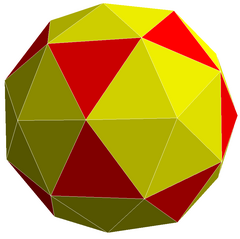Pentakis icosidodecahedron
| Pentakis icosidodecahedron | |
|---|---|

| |
| Conway notation | k5aD |
| Faces | 80 triangles (20 equilateral; 60 isosceles) |
| Edges | 120 (2 types) |
| Vertices | 42 (2 types) |
| Vertex configurations | (12) 35 (30) 36 |
| Symmetry group | Icosahedral (Ih) |
| Dual polyhedron | Chamfered dodecahedron |
| Properties | convex |
The pentakis icosidodecahedron is a convex polyhedron with 80 triangular faces, 120 edges, and 42 vertices. It a dual of the truncated rhombic triacontahedron.
Its name comes from a topological construction from the icosidodecahedron with the kis operator applied to the pentagonal faces. In this construction, all the vertices are assumed to be the same distance from the center, while in general icosahedral symmetry can be maintained even with the 12 order-5 vertices at a different distance from the center as the other 30.
It can also be topologically constructed from the icosahedron, dividing each triangular face into 4 triangles by adding mid-edge vertices. From this construction, all 80 triangles will be equilateral, but faces will be coplanar.
Related polyhedra
-
Icosahedron with each face subdivided into four equilateral triangles.
-
Pentakis dodecahedron is a slightly smaller Catalan solid which has 60 isosceles triangle faces, 90 edges (2 types), and 32 vertices (2 types).
-
Tripentakis icosidodecahedron, the Kleetope of the icosahedron, can be obtained by raising low pyramids on each equilateral triangular face on a pentakis icosidodecahedron. It has 120 isosceles triangle faces (2 types), 180 edges (3 types) and 62 vertices (3 types).
-
The nonconvex small icosihemidodecahedron looks like a pentakis icosidodecahedron with inverted pentagonal pyramids meeting at the polyhedron center.
Related polytopes
It represents the exterior envelope of a vertex-centered orthogonal projection of the 600-cell, one of six convex regular 4-polytopes, into 3 dimensions.
See also
References
- George W. Hart, Sculpture based on Propellorized Polyhedra, Proceedings of MOSAIC 2000, Seattle, WA, August, 2000, pp. 61–70 [1]
- John H. Conway, Heidi Burgiel, Chaim Goodman-Strass, The Symmetries of Things 2008, ISBN 978-1-56881-220-5
- Chapter 21: Naming the Archimedean and Catalan polyhedra and Tilings (p 284)
External links
- VTML polyhedral generator Try "k5aD" (Conway polyhedron notation)






